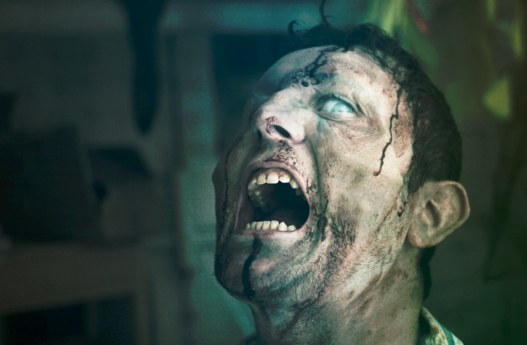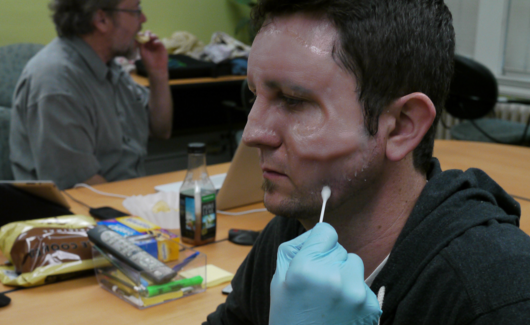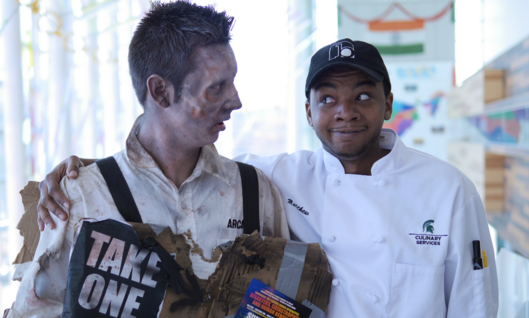BTN.com LiveBIG Staff, February 14, 2016
You?re walking to a class on a Tuesday morning, distracted as you read through last night?s text messages, when you unexpectedly trip over an object laying on the sidewalk. You get up and turn around to see what it was and are shocked to discover a human arm.
You take a step back and look around. You hear a guttural, groaning sound and, within seconds, you see a bloody and disheveled man limping toward you. You begin walking over to him when you notice a similar figure - no, make that two - stumbling behind him. You examine their faces and movements, and your brain makes the connection.
Zombies. On your college campus. Now, what do you do about it?

The question of what people would do to survive a zombie apocalypse has been discussed at length countless times over the past few years, in forums as varied as frat parties and social media hashtags. But Glenn Stutzky and his colleagues at Michigan State took answering that question to a whole new level.
Together, they designed a course that explores how humans respond - and how they should respond - to natural disasters and catastrophes, using the zombie apocalypse as the scenario. It came about when MSU?s School of Social Work needed to develop a summer online elective program that would appeal to the general student body.
?Preparing for the zombie apocalypse is essentially preparing for any disaster,? said Stutzky, a professor at the School of Social Work and head of the course.
From the beginning, Stutzky knew he wanted to do something different for this class, but he wasn?t quite sure what. He got some early inspiration from his grandson, who told him, ?Gramps, just don?t be boring.?
Stutzky was still thinking about that advice when he traveled to the Centers for Disease Control and Prevention (CDC) headquarters in Atlanta. (Incidentally, that location plays a key part in the zombie TV series ?The Walking Dead.?) While there, he noticed something unusual on one of their brochures.
?On the page looking back at me was a picture of a little girl, who was a zombie, peering through Venetian blinds,? he said.
Intrigued, Stutzky asked them why they were talking about a situation that was likely never going to happen.
?They said they weren?t getting a lot of attention on their site,? he explained. ?So they put this on there. They took a tongue-in-cheek approach.?
What the CDC started as something of a joke caught on in a big way. The traffic to its site grew nearly tenfold as a result of the organization?s zombie content. When Stutzky heard that, he knew he had a way to make his subject matter resonate.
With zombies as his creative muse, the professor began finding colleagues who could help execute this vision of a very different kind of college class. He also began fleshing out the storyline of the zombie apocalypse, which in the course starts off due to a ?coronal mass-ejection? from the sun that hits the Earth with unprecedented levels of energy and turns people into zombies, among other things.
Stutzky notes that this solar phenomenon really exists, and while he doesn?t claim it can actually create legions of brain-craving undead, he sees that sense of plausibility and realism as key to capturing and maintaining students? interest.

To reinforce those qualities, the team behind the course invests time into making it an immersive, emotional experience. Like a Hollywood production, they?ve spent hours working in makeup and wardrobe to bring the zombies in this scenario to life (or, perhaps, not-life). And they also developed a 90-second teaser trailer - with Stutzky starring in the lead role - to help attract new students to the class.
?We strongly believe education is a fantastic product,? he said. ?It should be promoted and advertised.?
?In today?s pop culture-saturated world, movies are becoming more like games, games are becoming more like movies, and new forms of hybrid media are in continual formation,? explained Christopher Irvin, an instructional designer for the course. ?It only makes sense that sooner or later education would do the same. What we?ve done is pull from all the various types of pop-culture media that learners consume on a day-to-day basis and weaved it together with cutting-edge academic content.?
Because of the innovation and effort behind it, the course is getting noticed beyond East Lansing. It received top honors in the Integrated Campaign and Course Promotional Trailer categories of Advertising for the Arts & Sciences? 2015 American Advertising Awards.
Another way in which the class stands out is how it?s united people with different talents, interests and backgrounds to create such a high-quality experience. It?s staffed with dedicated instructional designers Irvin and Keesa Johnson, as well as Hailey Mooney, the course librarian (or ?zombrarian,? as Stutzky puts it).
?Passion drives creation,? Johnson said. ?Without passion, we wouldn?t have put in the time, effort or work it required to create a course that never existed.?
?One of the most important things to me is the approach we?re taking to learning here,? Stutzky explained. ?It?s a collaborative approach. It?s not me as the professor, with the IT guy just bringing in his stuff and throwing it up on a screen. This was only possible with those people bringing their talents and passions together.?
[btn-post-package]In this way, the team embodies the central theme of the course: When you?re facing a disaster, catastrophe or apocalypse - and they are distinct categories, Stutzky points out - the people who survive are generally the ones who can establish relationships, build trust and find common cause.
?The biggest asset you can bring in is your relationships,? he explained. ?It?s not having weapons, water-purification systems or canned food. Those things are important, and they should be part of your preparation. But people have to be able to work together, which comes down to relationships.?
By Brian Summerfield







